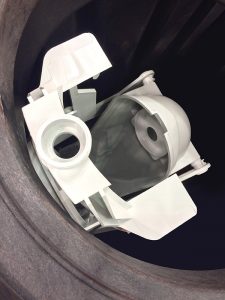
Grease management: Pitfalls to avoid
March 20, 2017 | By Andrew Bird
As unpleasant and challenging to work with as they are, grease interceptors are a necessary and vital part of the plumbing system for commercial, industrial and institutional applications.
The professional contractor has a number of roles to play in this arena and equally as many pitfalls to avoid. The quote by Benjamin Franklin “An investment in knowledge pays the best interest” is very appropriate.
In the simplest of terms, there are three key aspects of grease interceptors that you as a plumbing professional need to have an understanding of:
- Number one is the understanding of how and why interceptors work, or do not work (for more on this topic see HPAC March 2016).
- Second is the proper sizing of the interceptor for its intended application;
- and third is the correct installation of the interceptor to ensure it is able to function as intended.
Mastering these three areas of expertise will not only win you the respect and support of local plumbing inspectors, it will also position you as the go-to person for grease management in your area.
Yes, it can be a challenging and dirty job but that typically means money in your pocket.
Let’s take a look at those three key areas in more detail.
How and why do grease interceptors work or not work? Simply put, organic fats, oils and grease (FOG) are around 10% lighter than water. That means that given time alone, if you added a spoon full of vegetable oil to a mason jar and shook it up, the lighter FOG will rise to the top in about 30 to 40 seconds.
So why is it not that simple in an operational grease interceptor?
Detergents, surfactants, cleaning chemicals, food solids, and the plumbing system design itself all have impact, as does the type of menu served, seasonality or patterns of operation and of course the actions of staff within the kitchen of the premises.
Notwithstanding these influences, the simple answer may appear to be: “Put in the biggest tank possible and let gravity do its thing.”
Although, this is actually a much more common practice in the U.S. market, that approach has significant limitations and issues.
In Canada, the majority of interceptors are found inside the building or at least in a covered or semi-covered area, to protect them from our generally more aggressive climate. This means that the physical size of the unit becomes a constraint, both operationally and for installation. That is where design and performance aspects come into play.
The CSA B481 Standard series was first published in 2007 and later updated in 2012. The most comprehensive of its kind anywhere in the world, it sets out the performance, maintenance and installation requirements for grease interceptors with flow rates up to 100 gpm (6.4 L/sec).
After the 2012 updates were made, the standard was submitted to the National Research Council for inclusion in the National Plumbing Code of Canada and has progressively found its way into most provincial plumbing codes.
This standard validates the relative performance of different manufacturers’ products based on a defined laboratory test method allowing relative comparison. The bottom line is you must verify that the products you are recommending, purchasing and installing meet the requirements of CSA B481 and you must be familiar with the installation section in particular.
Remember this is not a choice in most provinces. It is or will soon become mandated to prevent the use of unqualified, shop-fabricated interceptors that ultimately put the health and safety of us all at risk.
“But what size of interceptor do I need?”
Having established that you have selected a qualified product meeting at least the minimum performance requirement, how do you correctly determine the right size interceptor for a particular application?
Unfortunately, neither “I just take the dimensions of what is left of the interceptor that needs replacing,” nor “What I am installing has to fit in the hole left by the old interceptor,” is the correct answer.
Interceptors are sized based on flow capacity with a method defined in the same CSA B481 series. There are many unknowns in the ‘size for size’ replacement approach that opens the contractor to all kinds of operational issues and ultimately callbacks.
- Consider:
How the interceptor was sized originally (likely prior to B481). - Has any equipment in the kitchen been added or removed that increases or decreases flow rate to the interceptor?
- Was there a flow control device in the original installation?
- Has the ownership/food type changed?
- Has the business grown significantly increasing the frequency and type of discharges?
As a plumbing professional, your priority and obligation to the customer is to properly review the total discharge flow rate and determine the correct size of interceptor. Only then can the consideration of “Does that fit in the current space or do we have to get creative?” come into play.
The sizing method does allow a convenience factor in respect of either a one- or two-minute average discharge time. If the local jurisdiction allows, the use of a two-minute drain time in the simple calculation has the effect of reducing the flow rate by half and therefore also reducing the physical size of the unit.
At face value, both you as the installer and the foodservice operator may be happy with that outcome, however in your professional capacity you should make it clear that halving the physical size of the interceptor essentially means doubling the maintenance frequency for the restaurant/facility.
On average a third-party pumper will charge between $90 and $140 per clean out, typically on a four- to six-week cycle.
You can see that pretty quickly, where a saving was delivered on the one hand, the ongoing impact of that decision quickly consumes the benefit – not to mention the increased inconvenience to more frequent access being required. Ask yourself who is gaining financially from that decision.
Today, manufacturers offer simple online and mobile tools to help size these applications quickly and effectively so that you can be confident in your recommendations.
So now you have defined the correct size of interceptor required. You have made your professional recommendation and the client has accepted your quote. It is time to install.
In comparison to many other plumbing appliances the grease interceptor is pretty simple to install. Unfortunately, this often gives rise to a level of complacency during installation.
One key component that often provides specific challenge is the flow control device. Statements heard too frequently from the marketplace include:
- “Do I have to fit this flow ‘thing’ or is it optional?”;
- “There was no space so I didn’t put it in”;
- or “That little hole will get (or keeps getting) blocked so I just drilled it out.”
The bottom line is that flow control is an essential element of the hydro mechanical grease interceptor. The orifice is engineered to a specific diameter for an important dual purpose.
Some older interceptors, particularly steel/epoxy products, had an integrated flow control. As time moved on and performance standards developed, external flow controls had more of a presence.
In either regard, the orifice diameter is defined and validated as part of the certification testing and is a non-negotiable element of the installation.
In addition to the orifice, an air intake is provided immediately following it. Those of you who remember your school days, may remember Bernoulli’s Principle. Put simply, the rate of flow through the orifice causes the water to accelerate and creates a negative pressure zone, at which point we make air available (air intake/vent) so that air gets entrained or mixed with the wastewater.
This mixing makes the density of the flow lower. The air, and in this case grease, are actually attracted to each other at a molecular level.
These attributes, in conjunction with the interceptor’s overall design, result in its effectiveness and efficiency of operation.
Cover the air intake, and your interceptor loses in excess of 30% of its effectiveness. So is flow control necessary – absolutely and definitively yes. <>





